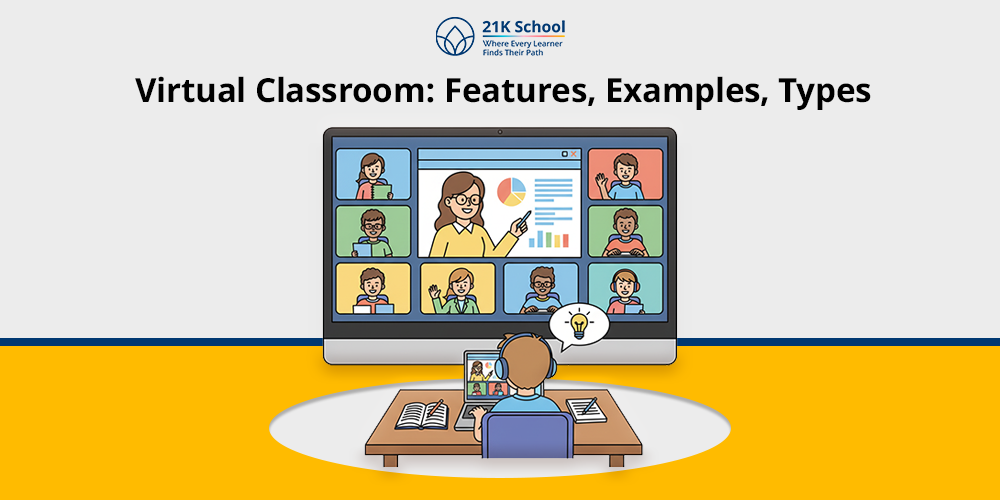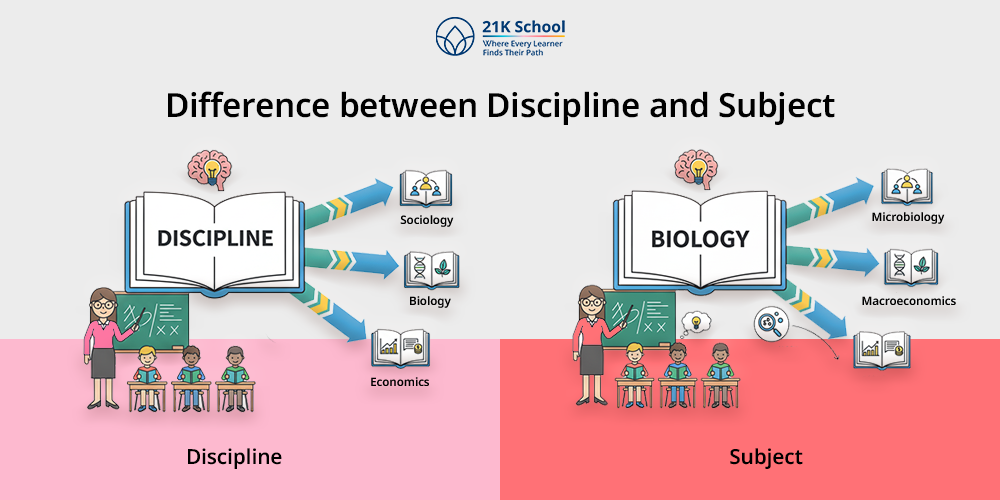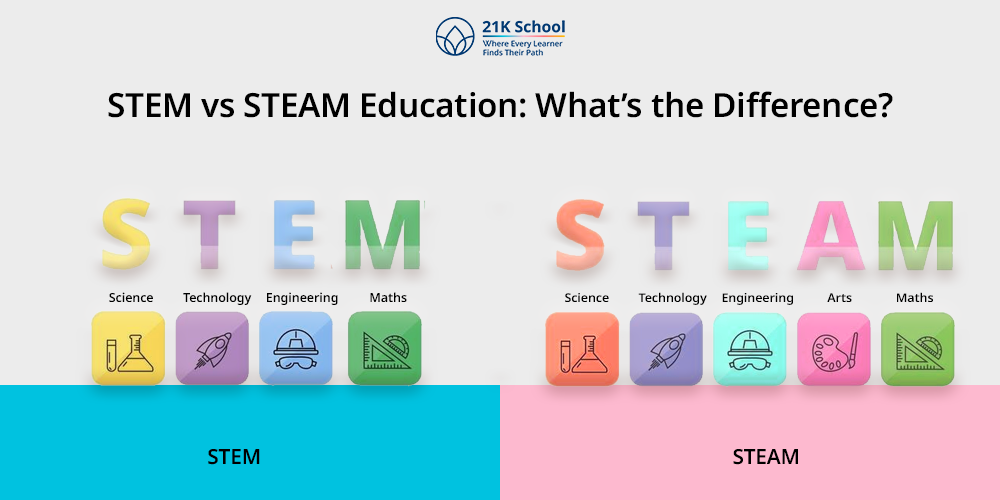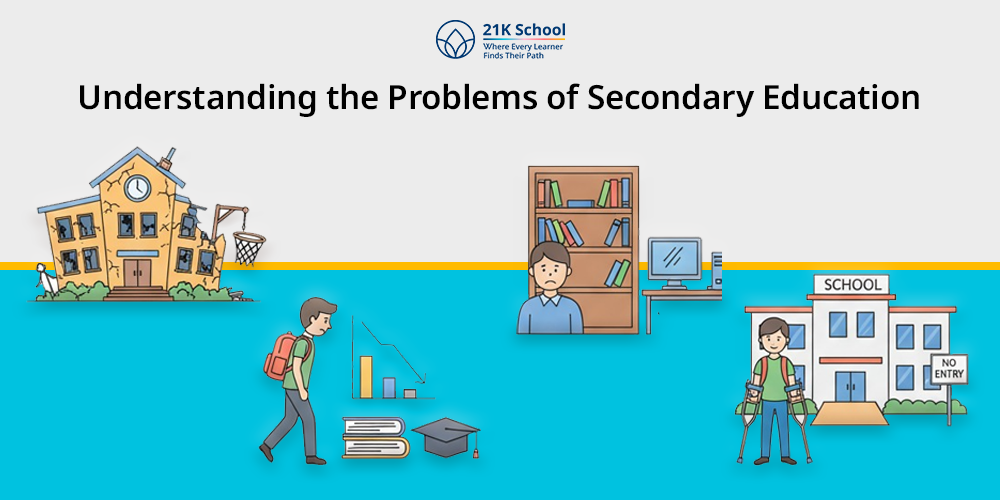
Almost all students from 14 to 18 years enter the secondary formation of education.
In the largest systems of education the transition is at the secondary level. Secondary education teaches the theories but also prepares the learner for the future .
In secondary formation of learning there are grades 9 to 10 and 11 to 12 which are higher secondary grades. Students still think secondary education has many disadvantages that will trouble them.
They stop students from learning and are therefore unmanageable when they try to get their own results. Growth problems in secondary education are discussed next.
Contents
- Top 14 Problems of Secondary Education
- 1. Improper Teacher-Student Ratio
- 2. Lack of Infrastructure
- 3. Lack of Resources
- 4. Lack of Practical Knowledge/Skill-Based Knowledge
- 5. Student Dropout Levels
- 6. Lack of Equity & Access
- 7. Outdated Curriculum
- 8. Shortage of Teachers
- 9. Insufficient Teacher Training
- 10. Focus on Summative Assessment
- 11. Insufficient Guidance
- 12. Lack of Student Motivation
- 13. Lack of Critical Thinking
- 14. Lack of Inclusive Education
- Solutions to Secondary Education Problems
- 1. Updating Curriculum
- 2. Sufficient Funding
- 3. Emphasis on Practical Knowledge
- 4. Training the Teachers
- 5. Setting up of Vocational Institutes
- 6. Using Technology
- 7. Good Ratio of Teacher to Students
- 8. Proper infrastructure
- 9. Collaborative Learning Environments
- 10. Increasing Educational Opportunities
- 11. Focus on Rural Area
- 12. Inclusive Learning Environment
- Conclusion
Top 14 Problems of Secondary Education
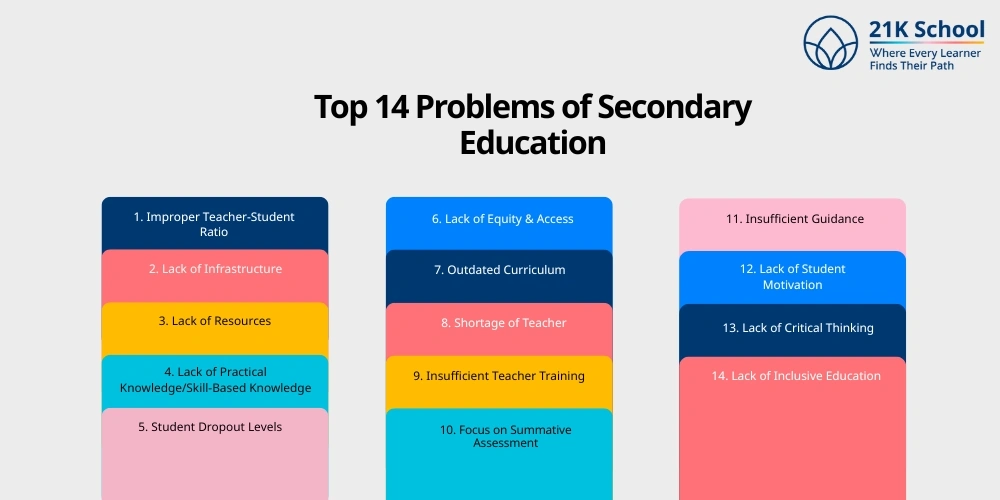
The problems of secondary education include poor infrastructure, unqualified teachers, old curriculum , etc. Here are the following problems of secondary education mentioned below.
1. Improper Teacher-Student Ratio
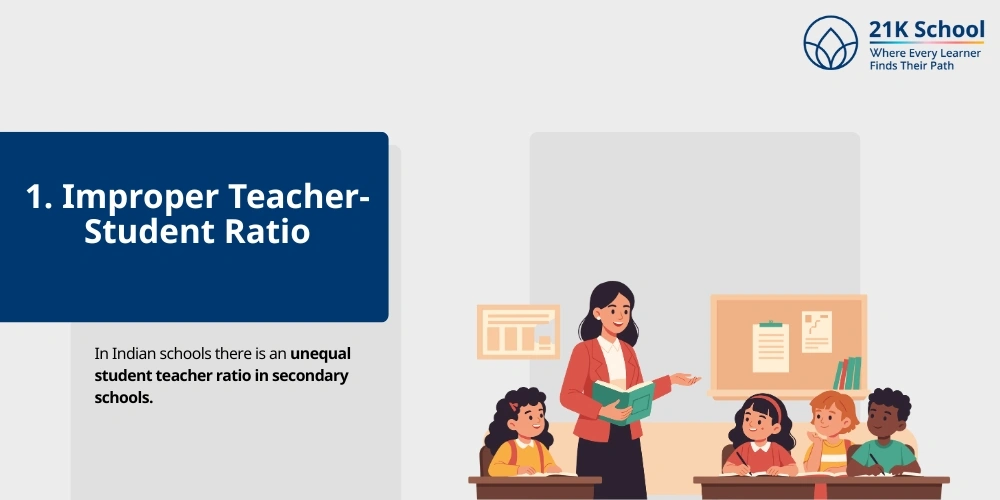
In Indian schools there is an unequal student teacher ratio in secondary schools. Wherever you go in India you have way too many teachers – a teacher has on average 20-10 students.
Less teachers and the wrong ratio slow down a student’s normal speed of learning. Then there’s also the teacher-student relationship and student satisfaction is poor as a result.
2. Lack of Infrastructure
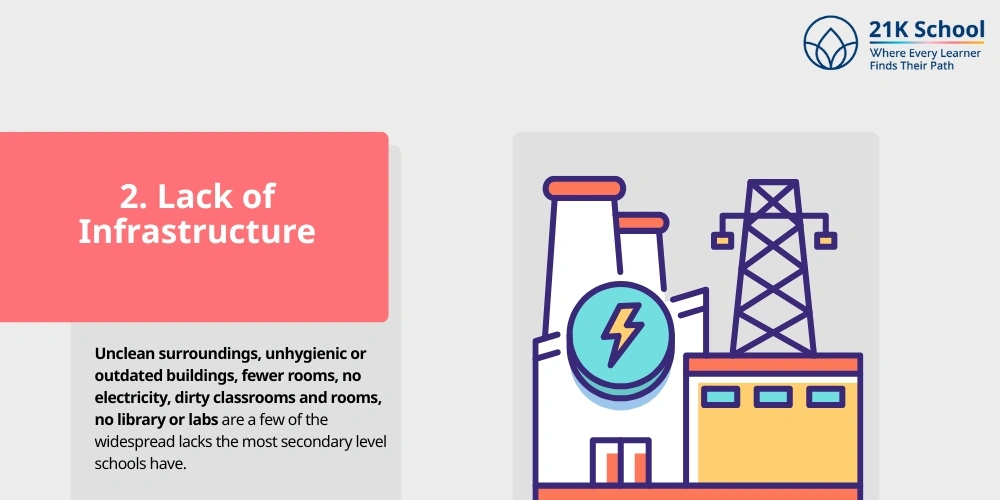
Another very challenging problem that students of secondary level face in rural or underprivileged areas is the scarcity of infrastructure.
Unclean surroundings, unhygienic or outdated buildings, fewer rooms, no electricity, dirty classrooms and rooms, no library or labs are a few of the widespread lacks the most secondary level schools have.
3. Lack of Resources
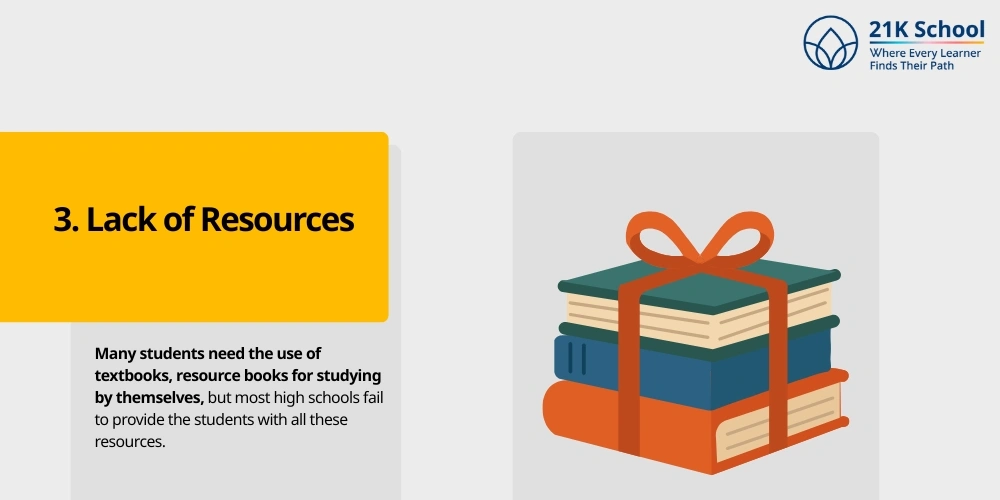
Many students need the use of textbooks, resource books for studying by themselves, but most high schools fail to provide the students with all these resources.
Tablets, computers and the service of the internet in the schools as well as in the libraries are counted as few of the important resources for creating the base of a healthy learning atmosphere. Even the teacher may also lack the access to teaching aids and resources, which will make the learning method difficult for the students.
4. Lack of Practical Knowledge/Skill-Based Knowledge
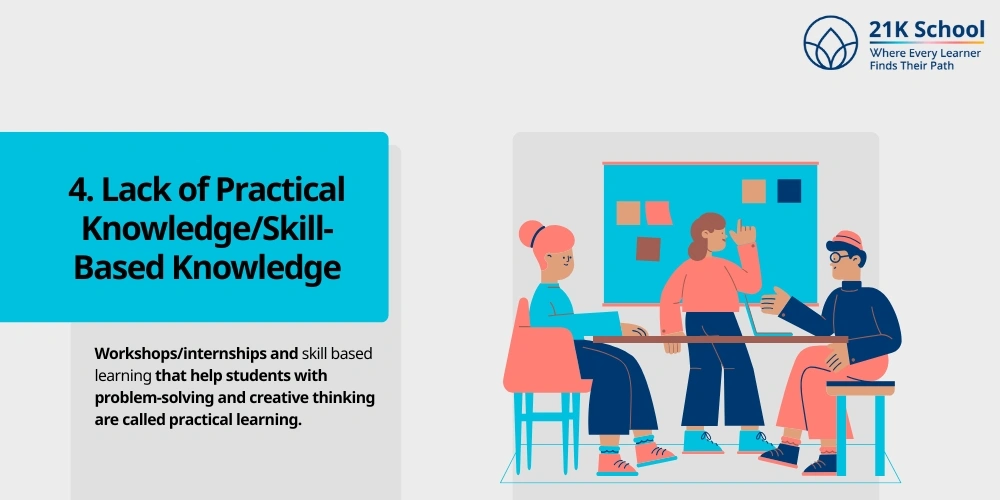
The secondary education is mostly theoretical with little practical and vocational training. In secondary classes there isn’t much practical education and students have trouble putting learning into practice.
Workshops/internships and skill based learning that help students with problem-solving and creative thinking are called practical learning.
5. Student Dropout Levels
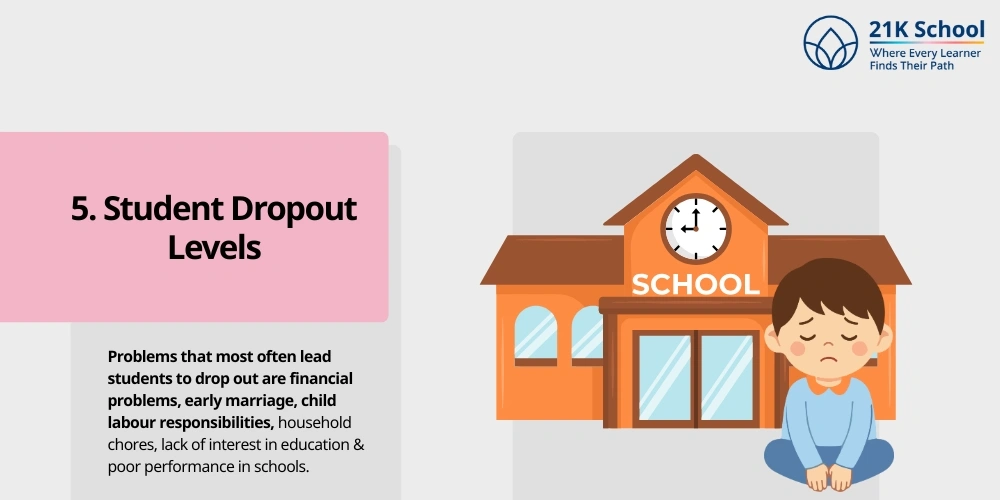
Today schooling and student dropout are among the biggest issues in secondary education. Problems that most often lead students to drop out are financial problems, early marriage, child labour responsibilities, household chores, lack of interest in education & poor performance in schools.
Dropout rates are a problem to address because they lower school enrollment and increase youth unemployment. Now though, with the new NEP 2020 and other educational techniques the dropout rate is down.
6. Lack of Equity & Access
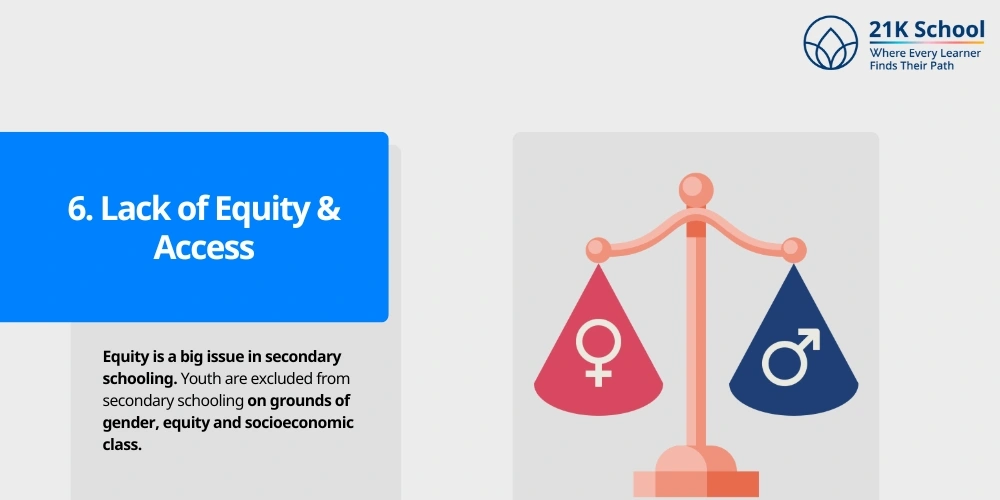
Equity is a big issue in secondary schooling. Youth are excluded from secondary schooling on grounds of gender, equity and socioeconomic class.
And at times girls do not go to school because it is unsafe or maybe it’s not consistent with the lifestyle of the land. Parents could not afford tuition, and in some cases, transportation, and uniforms to school.
7. Outdated Curriculum
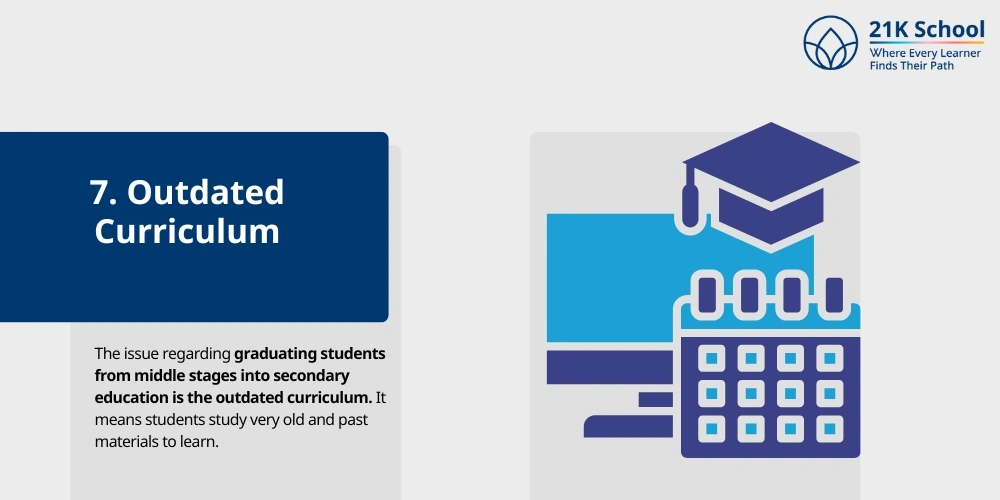
The issue regarding graduating students from middle stages into secondary education is the outdated curriculum. It means students study very old and past materials to learn.
Students struggled to take the knowledge gained through studying from the outdated curriculum into today’s world. One of the major issues out-of-date curriculum creates, it makes the students approach learning less.
But NEP 2020 also reintroduced the curriculum and updated the information, with more focus on practical learning.
8. Shortage of Teachers
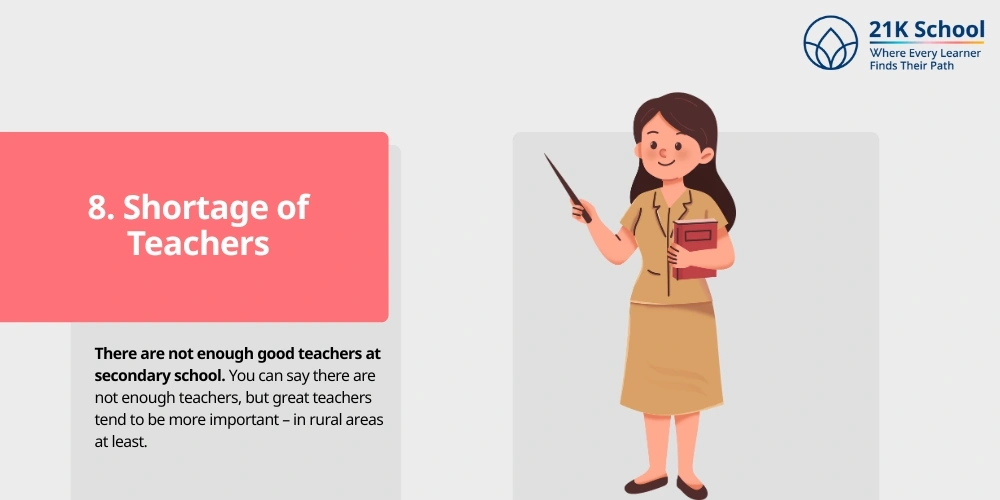
There are not enough good teachers at secondary school. You can say there are not enough teachers, but great teachers tend to be more important – in rural areas at least.
Reasons are low salary, working conditions, no career mobility, moving to cities, privatisation from rural areas. Hence, many schools have a lot of problems hiring and keeping good teachers. But the new implementation of NEP 2020 also targets better quality teachers to avoid teacher shortages.
9. Insufficient Teacher Training
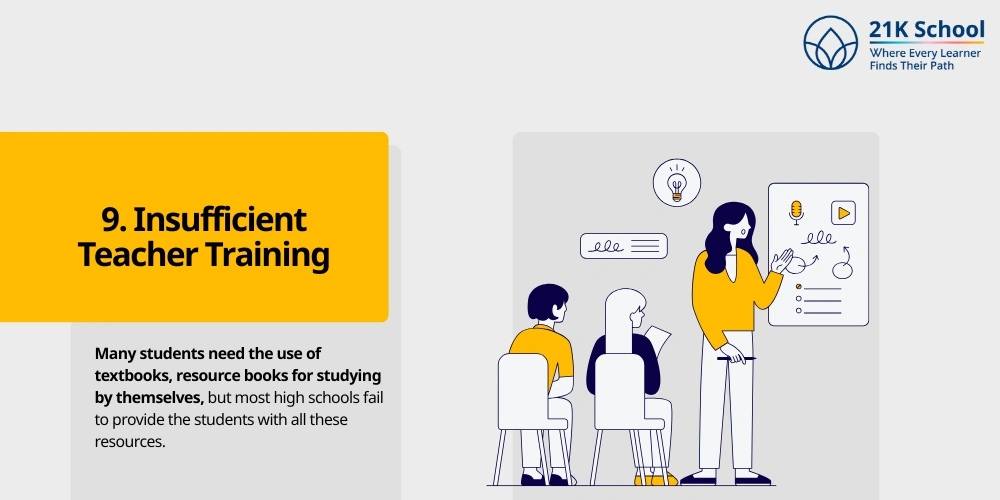
The teacher will develop with the newer pedagogical models of the content areas, content knowledge and classroom management strategies but teacher training and professional development are insufficient.
Whenever that happens, when teachers just do what is easiest, they just teach all the old ways in the classroom and nothing will help any more in teaching every student better instruction. But even after that, the government also trains and practices teachers through teachers’ training institutes..
10. Focus on Summative Assessment
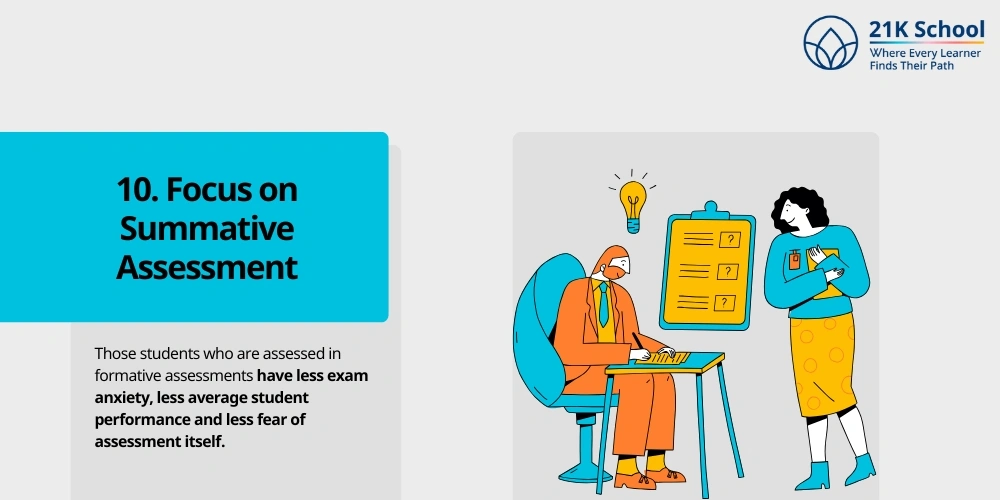
In the Indian education system , students are given summative assessments . Those students who are assessed in formative assessments have less exam anxiety, less average student performance and less fear of assessment itself.
Since the assessment happens in class students do not understand the topic and are anxious about it.
11. Insufficient Guidance
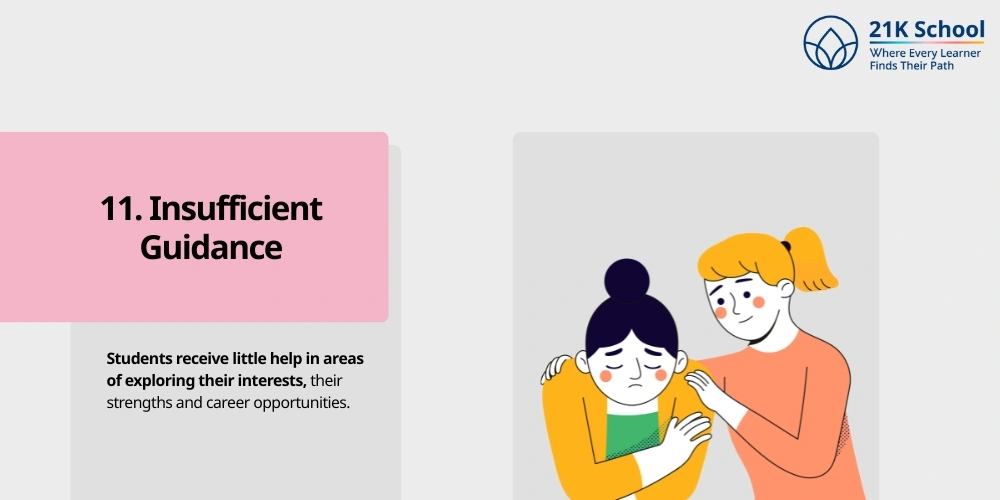
Students receive little help in areas of exploring their interests, their strengths and career opportunities.
With no proper guidance, students may make an uninformed decision on the selection of skills, higher education/vocational education and become the victims of skills-employment mismatch.
12. Lack of Student Motivation
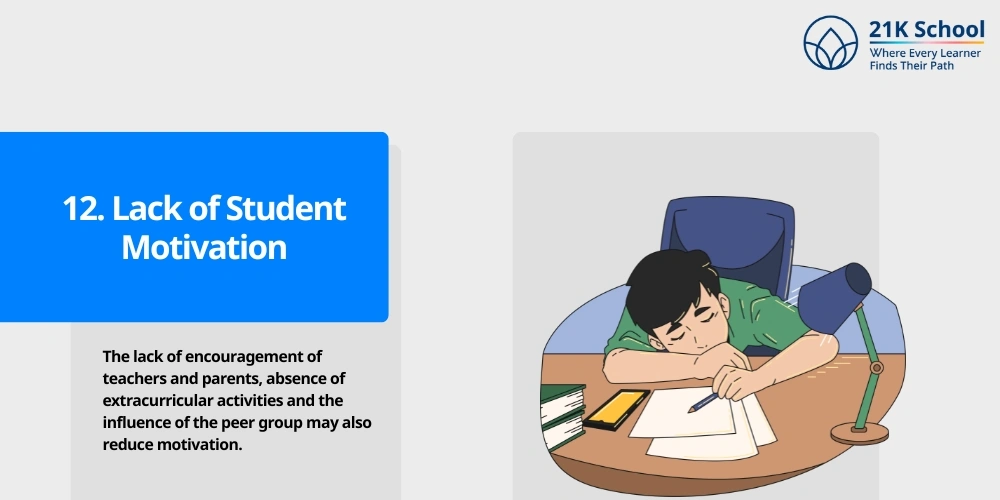
The lack of encouragement of teachers and parents, absence of extracurricular activities and the influence of the peer group may also reduce motivation.
Student motivation depends on the relevance of the school curriculum, teaching methods , school environment and support systems.
13. Lack of Critical Thinking
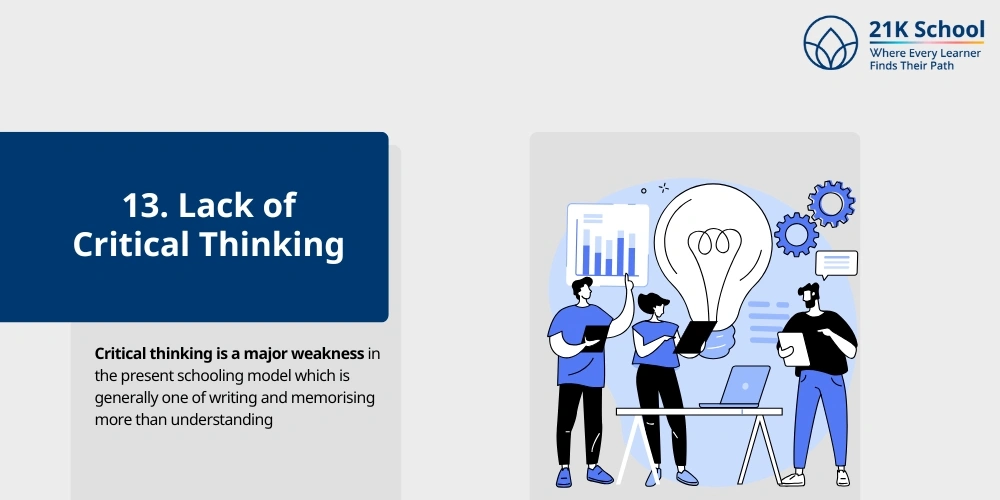
Critical thinking is a major weakness in the present schooling model which is generally one of writing and memorising more than understanding.
And eventually students will have trouble adapting to the complex and fast changing future if they do not see the importance of things that can be critically thought of.
14. Lack of Inclusive Education
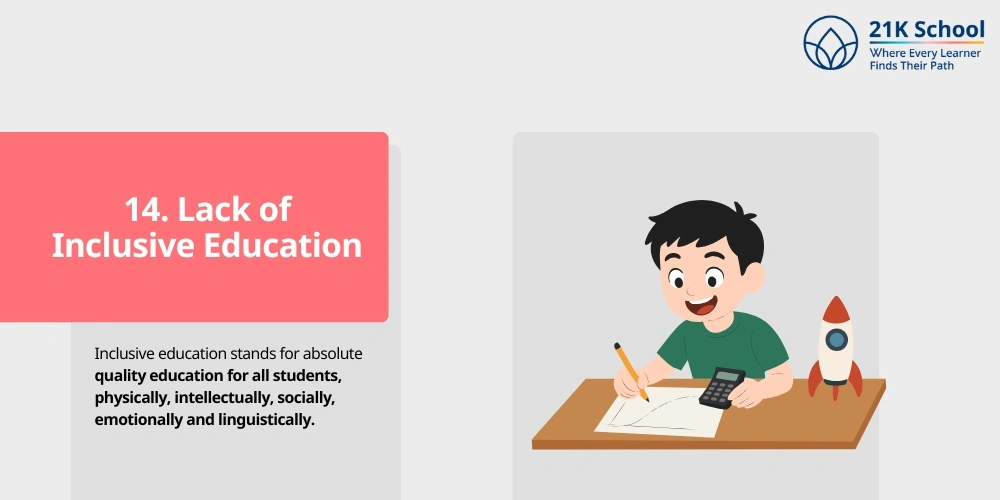
Inclusive education stands for absolute quality education for all students, physically, intellectually, socially, emotionally and linguistically.
Almost all of the secondary level schools have no resources, facilities or trained staff members to serve students with disabilities or any special needs and this denies them equal chances, also isolates them and sometimes discriminates against them.
Solutions to Secondary Education Problems
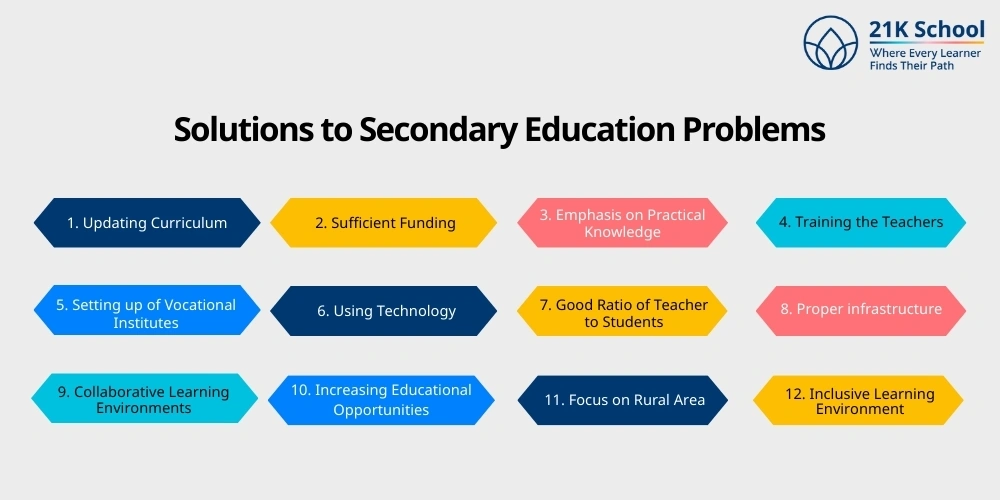
The secondary education problem will be solved by government support and new efforts to change the old system will be made. Here are the ways through which the problems of secondary education can be avoided.
1. Updating Curriculum
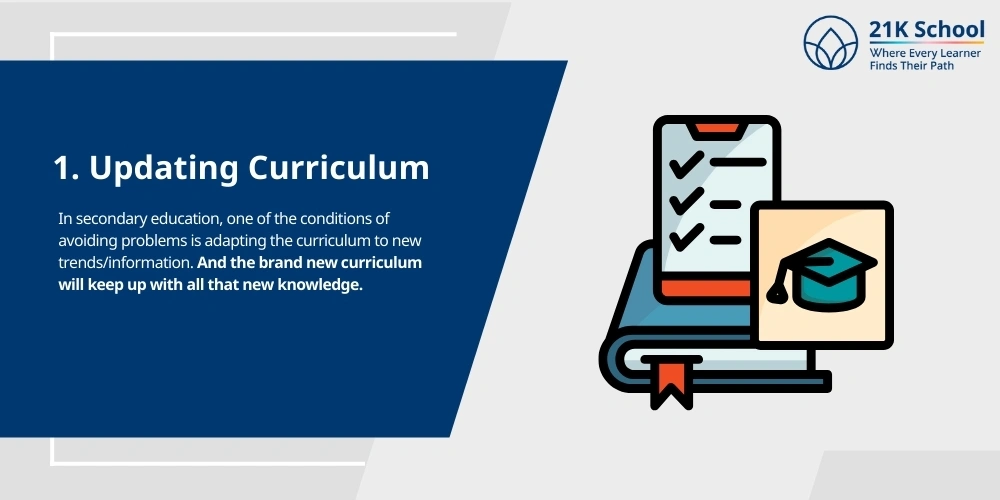
In secondary education, one of the conditions of avoiding problems is adapting the curriculum to new trends/information. And the brand new curriculum will keep up with all that new knowledge.
That will help the students to collaborative with others that will help them choose the right career.
2. Sufficient Funding
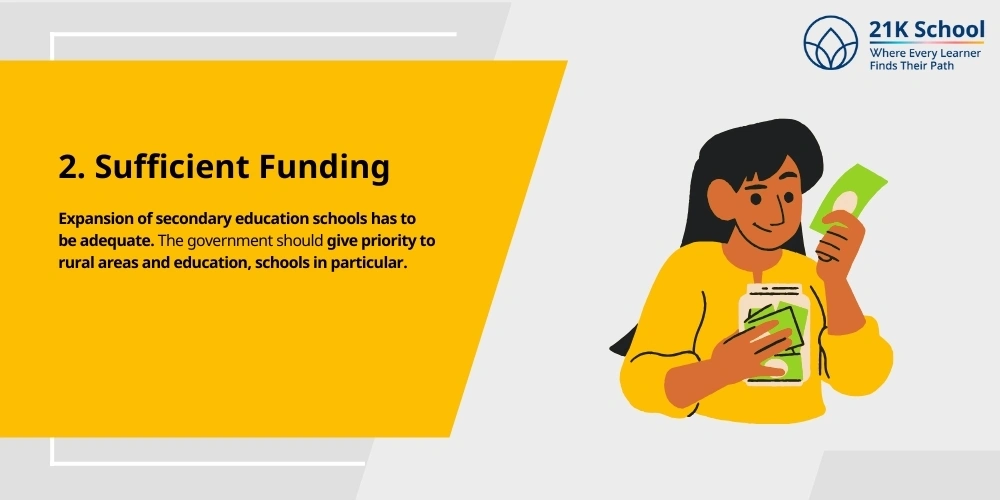
Expansion of secondary education schools has to be adequate. The government should give priority to rural areas and education , schools in particular.
If funding is there, infrastructure can be built, and the best quality teachers hired to teach in these schools.
3. Emphasis on Practical Knowledge
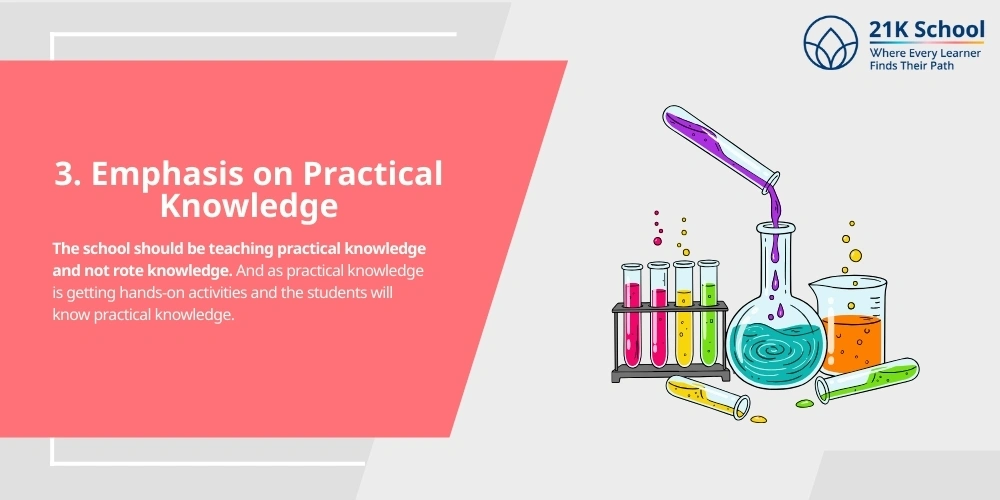
The school should be teaching practical knowledge and not rote knowledge. And as practical knowledge is getting hands-on activities and the students will know practical knowledge.
That gives them experience. Also the student will work on the problem and get familiar with actual world situations.
4. Training the Teachers
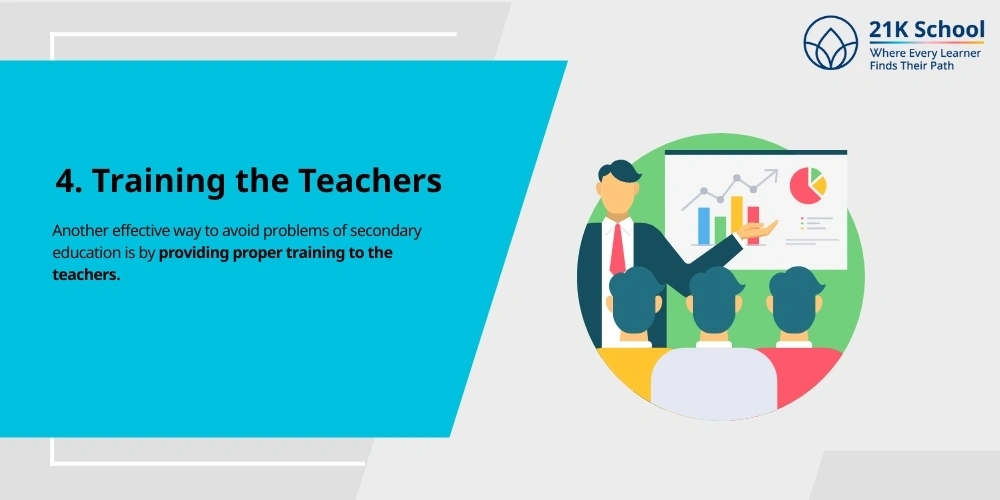
Another effective way to avoid problems of secondary education is by providing proper training to the teachers. Many teachers have non-proper teaching knowledge as well as the proper methods for providing the students with the piece of information.
Because of this, many of the children find the class boring as well as difficult to relate with the teachers.
5. Setting up of Vocational Institutes
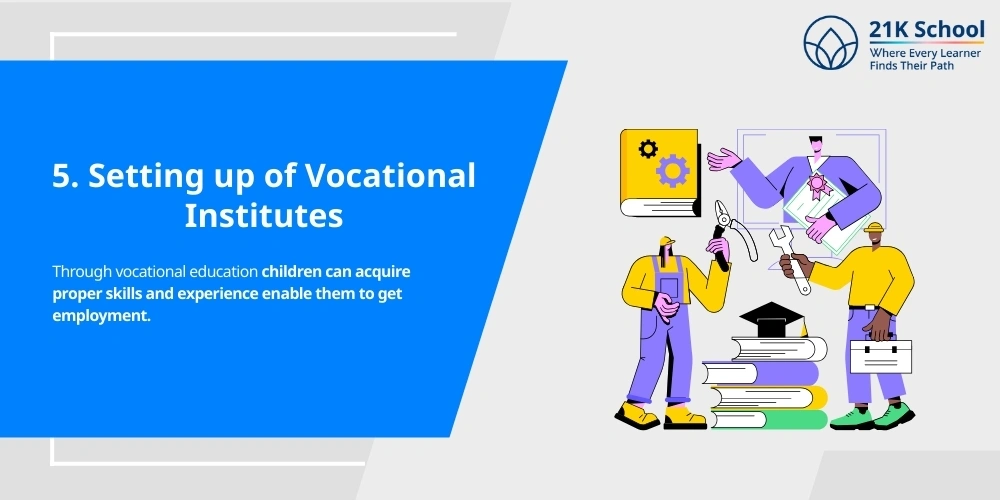
Setting up vocational training institutes is an incredible way to avoid the problem of secondary education.
Through vocational education children can acquire proper skills and experience enable them to get employment. This also allows them to relate the real world with their learnt skills, necessary to get prepared for the competitive job market.
6. Using Technology
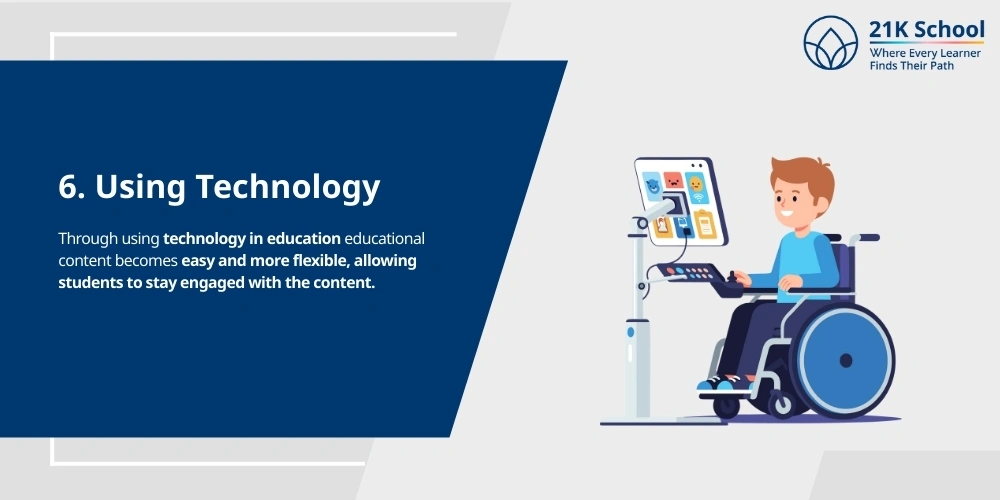
The contribution of technology into education plays a vital role in developing the educational experience of students. Through using technology in education educational content becomes easy and more flexible, allowing students to stay engaged with the content.
Even with online learning , every student can learn at their own home without any limitation, which improves the condition of secondary education.
7. Good Ratio of Teacher to Students
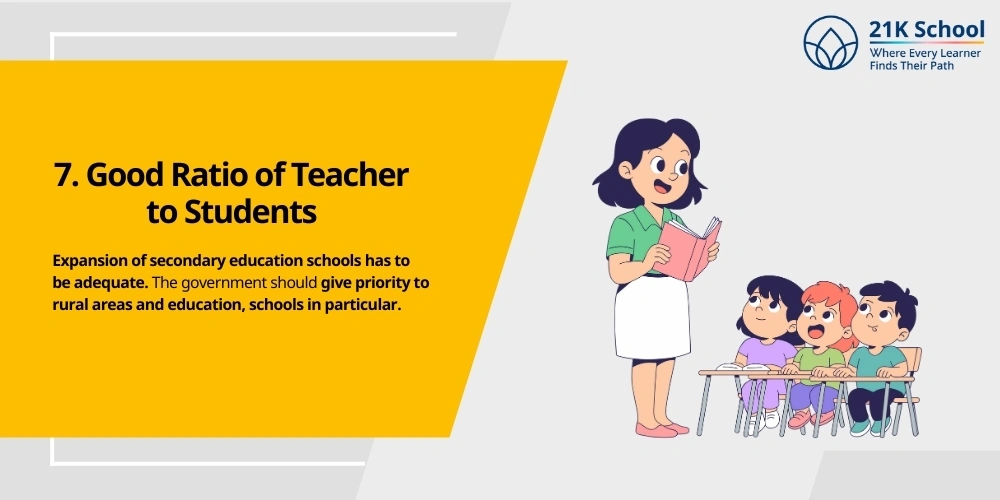
A good teacher to student ratio has proved to improve student learning. And then the instructor can give more attention to each student – help them with their education – than they can now.
In case you wanted to get correct student to teacher ratios, each class would have to be split into periods or sections so that the ratio was split equally between them in terms of educator to student ratio.
8. Proper infrastructure
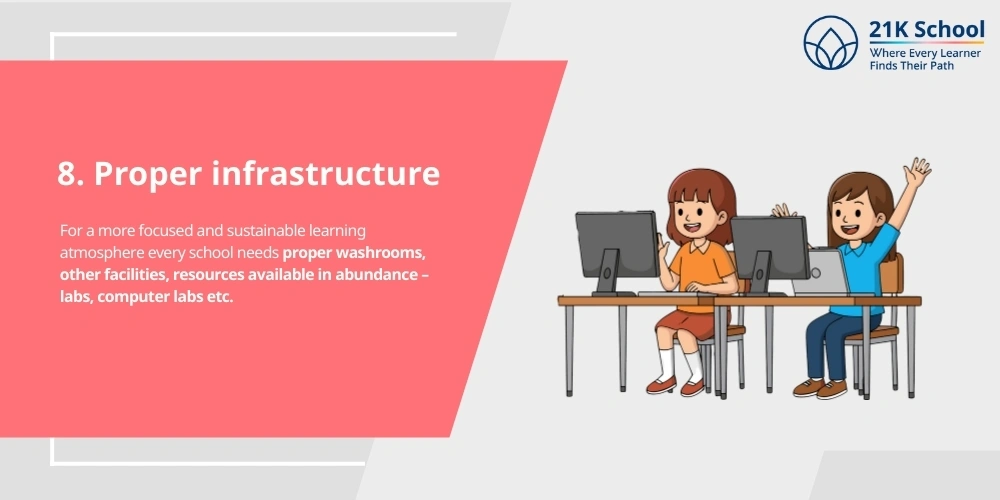
For a more focused and sustainable learning atmosphere every school needs proper washrooms, other facilities, resources available in abundance – labs, computer labs etc.
It won’t increase the capability to learn but it is going to solve the issues of the Indian educational system.
9. Collaborative Learning Environments
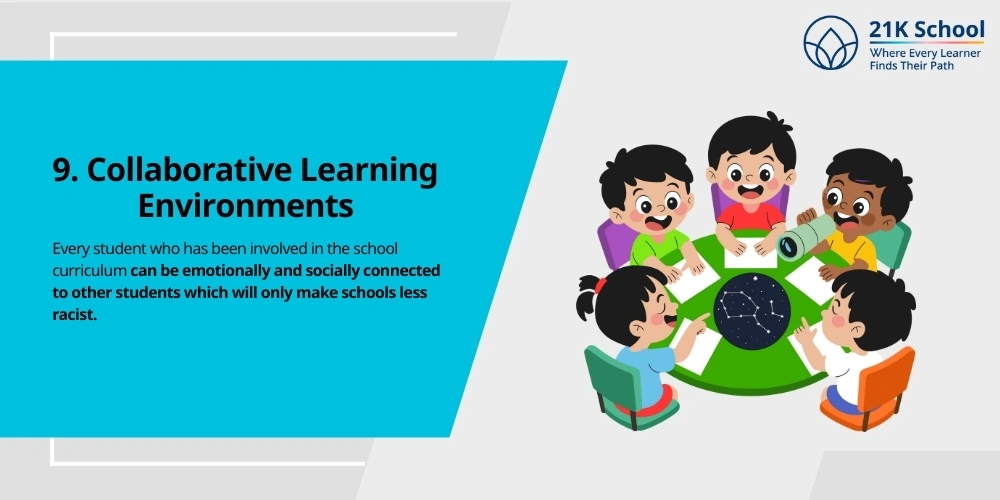
It is a peer learning environment. Every student who has been involved in the school curriculum can be emotionally and socially connected to other students which will only make schools less racist.
Also, collaborative learning may make students do group work as well.
10. Increasing Educational Opportunities
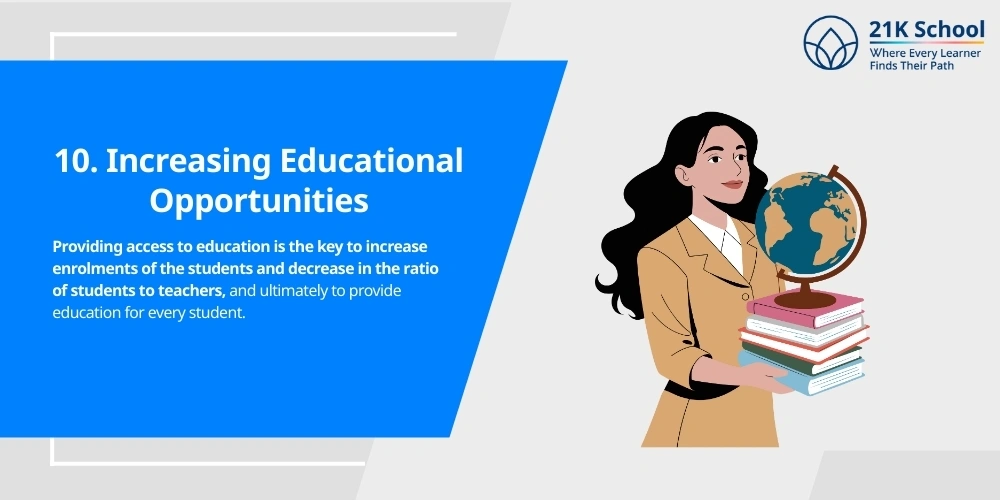
Providing access to education is the key to increase enrolments of the students and decrease in the ratio of students to teachers, and ultimately to provide education for every student.
A successful example of equal opportunity of education is the use of the form of online schools and education such as 21K school . The type of education also ensured that the education provided is of fine quality and any student can have access to the learning.
11. Focus on Rural Area
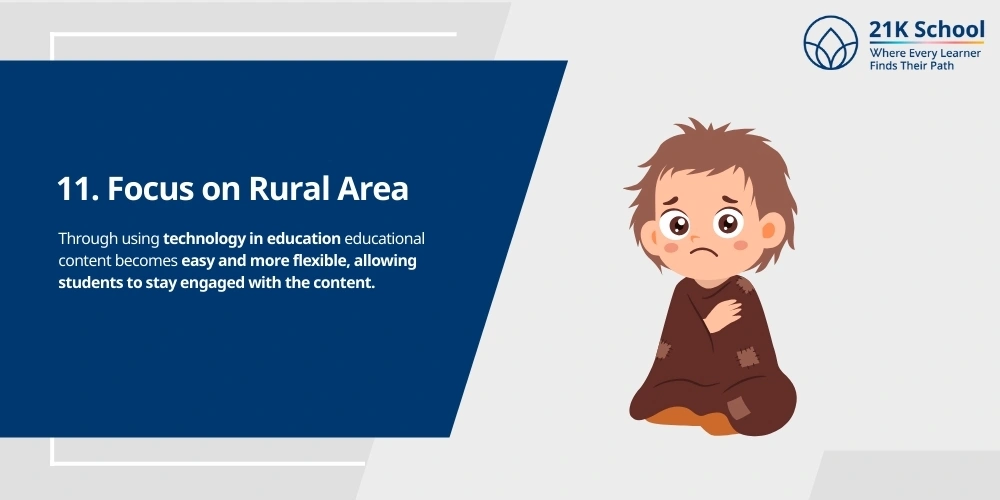
To end the failure of secondary schooling the government should concentrate on the rural areas. Most of the rural children do not receive a good education.
Establishment of schools in the rural setting and addressing the matter of affordable education are factors that help in increasing the number of students taking education in the senior secondary level.
12. Inclusive Learning Environment
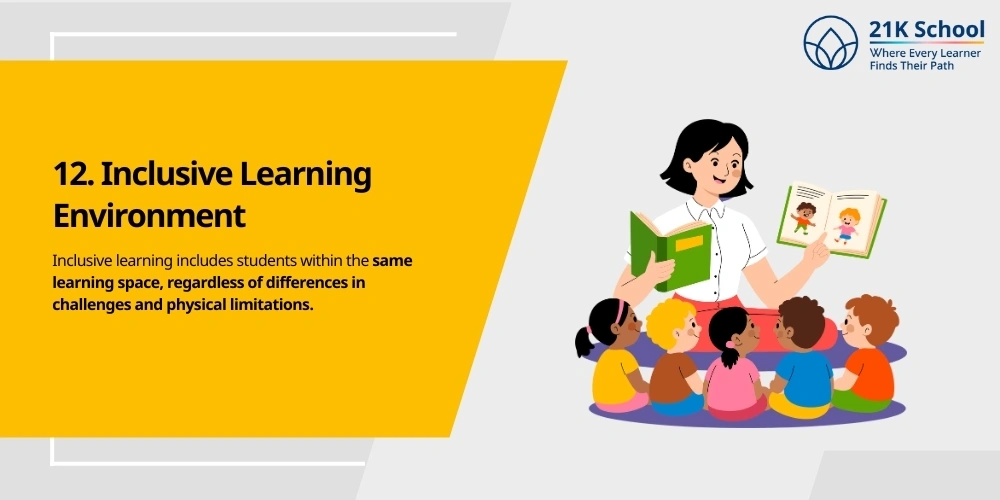
All schools need to develop an Inclusive learning environment. Inclusive learning includes students within the same learning space, regardless of differences in challenges and physical limitations. On top of that an advantage to inclusive learning is positive and supportive learning.
Conclusion
In India, secondary education is under many challenges such as poor infrastructure and outmoded curriculum, lack of teachers and practicability of learning. These problems undermine total development of the students and restrict their future.
Nonetheless, through concerted action like revision of curricula, infrastructure enhancement, motivation of teachers, encouragement of inclusive and practical education, the quality and efficiency of secondary education can be greatly enhanced.
These issues need to be solved to empower students to have a successful and productive future.

